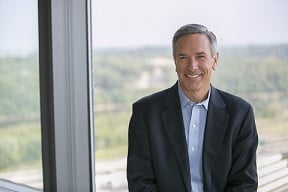
We talk to Johnson & Johnson’s global HR leader about his HR priorities for 2017 and data analytics

Peter Fasolo has global responsibility for HR at Johnson & Johnson, and reports directly to the chairman and CEO.
“Probably most importantly, I have the real privilege of helping to look after our 120,000 employees and their families around the world,” he said.
Fasolo talks to HC about about his HR priorities for 2017, data analytics and much more.
Can you outline the credo and why it’s so critical to how Johnson & Johnson operates?
PF: The first and foremost responsibility we have as a company is to ensure we’re providing high quality, innovative products to the nurses, doctors, mothers, fathers, families that we have the privilege to serve.
The second responsibility we have is to the employees in our company around the world. Our responsibility is to provide them a safe environment. We should pay close attention to their careers and give them a sense of security, and create an environment where their careers can flourish.
The third responsibility we have is to the communities in which we serve around the world. We give back to our communities. Well over 85% of our employees are involved in some level of community engagement and volunteer work. We give over $US1bn worth of products/services back into our communities each year. We are a company that is committed to sustainability and to alternative ways for energy – solar, water conversation.
Fourth is a responsibility to our shareholders. Our credo guides us. If you take care of your patients with high quality, innovative products and you are committed to your employees and give back to your community, the shareholder will get a fair return. Those constituents and stakeholders are ordered in this way for a reason. That credo, that guidance, has been a real north star for the company for decades. It served us well then and it serves us extraordinarily well today.
What’s on top of your HR agenda in 2017?
PF: We are literally halfway through a big transformation journey of our own HR function. We are dis-aggregating the HR function, meaning we’re putting the more transactional, administrative work into a shared service environment in places like Tampa, Florida, in Prague, Czech Republic and Manila in the Philippines.
These are high service, repetitive support functions. Things like recruitment, performance management, comp management can be done universally and very effectively. It also allows our corporate centres to focus on the talent agenda, for example, the comp strategies, and then our business partners can support their businesses more effectively.
Where have those shared services functions been based prior to this point?
PF: The HR business partner was essentially doing everything on behalf of the function. We did have centres of excellence – in recruiting, in compensation – where there were global policies and frameworks in place, but the fact of the matter is before this transformation our HR business partners were doing a lot of this work themselves. What that resulted in was unevenness in service levels and lots of different approaches to things like performance management or succession planning.
I want our HR leaders to be in the talent game, to be rewarded for outcomes rather than process. I want to invest in software as a service and cloud technology so we can leverage the scale of J&J and we don’t have to debate the variety of ways to do performance management, employment relations or comp admin or recruiting – we’ll have the best practices and be able to scale up.
How does Johnson & Johnson’s HR team tap into big data for decision-making?
PF: We’re currently building out a pretty robust people and data analytics capability, because as you go and dis-aggregate the HR function, you have HR business partners focusing on the agendas I’m describing, and you have to build out capabilities to ensure line leaders and HR leaders have insight into their workforce.
So we now have a 15-20 person data analytics group, which is providing insights into what works and doesn’t work, what are the best predictors of success, and how people are moving around the globe in terms of their careers. At J&J we do around 25,000 job placements a year: 60% on the outside, 40% on the inside.
That’s a huge number of movements to keep track of. We have thousands of people who are on expatriate assignments, who are third country nationals, as well as undertaking inpatriate assignments. We want to make sure those movements are being tracked and outcomes are being understood so we can leverage insights for maximum impact.